One should cover a pan while heating?
The legend
You should always cover a pot of water you want to boil, so that it boils faster.In other words, if you're heating water (or anything else), boiling is achieved more quickly if the pan is covered than if it's not.
How to check?
Boil 1 liter of water in a covered pan, timing the time, then 1 liter of water in an uncovered pan, again timing the time.Comparing the times will show whether you really need to cover the pot to go faster.
Let's check:
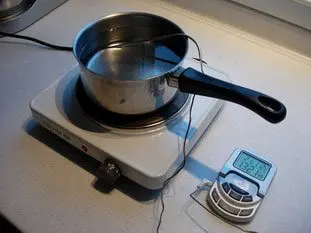 We measure 1 liter of water and place it in an uncovered saucepan on a hotplate, into which we dip a thermometer.
We measure 1 liter of water and place it in an uncovered saucepan on a hotplate, into which we dip a thermometer.
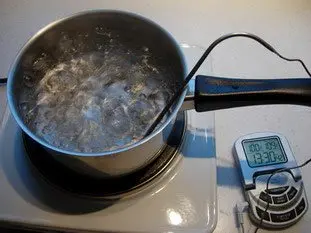 Turn on the stove and start the timer, reaching 100°C (210°F) in 9 minutes and 30 seconds.
Turn on the stove and start the timer, reaching 100°C (210°F) in 9 minutes and 30 seconds.The stove is left to cool down for about an hour, returning to room temperature.
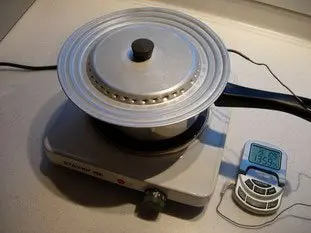 Another 1 liter of water is measured and placed in a covered saucepan on the stove, still using a thermometer.
Another 1 liter of water is measured and placed in a covered saucepan on the stove, still using a thermometer.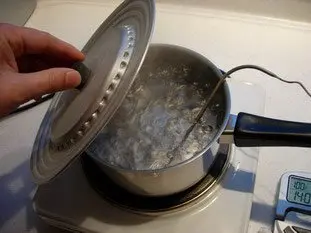 Turn on the stove and start the stopwatch, reaching 100°C (210°F) in 9 minutes and 27 seconds.
Turn on the stove and start the stopwatch, reaching 100°C (210°F) in 9 minutes and 27 seconds.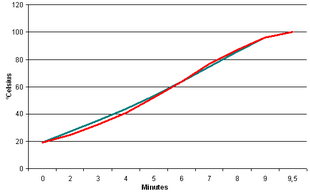 The result is even more obvious if you compare the temperature curve, with the uncovered pan in red and the covered pan in green.
The result is even more obvious if you compare the temperature curve, with the uncovered pan in red and the covered pan in green.Conclusion
The time difference is too small to be significant: covered or uncovered, it's practically the same thing.Some people have pointed out to me that if we were using a (much) larger volume of water, it wouldn't be the same; the lid would be effective, but in home cooking, we only use small volumes.
To sum up:"You should always cover a pot of water you want to boil, so that it boils faster", is not true.
Lasts posts
Butter vs. grease
We often read in a recipe where a pastry is put into a mould that, just before pouring, the mould should be buttered or greased. But what's the difference between these 2 terms?December 1st 20251,0515
Getting out of the fridge early
Very often when you're cooking, you need to take food or preparations out of the fridge, to use them in the recipe in progress. There's nothing tricky about this: you just take them out of the fridge and use them, usually immediately, in the recipe. But is this really a good method?November 24th 20251,1535
Who's making the croissants?
When you look at a bakery from the outside, you naturally think that in the bakery, the bakers make the bread, and in the laboratory, the pastry chefs make the cakes. It's very often like that, with each of these professions having quite different ways of working, but sometimes there's also one...November 23th 20251,046
Oven height
When we put a dish or cake in the oven, we naturally tend to put it on the middle shelf, and that's what we usually do. But in some cases, this position and height can be a little tricky, so let's find out why.October 8th 20252,8285
The importance of sieving
In recipes that use a fine powder (flour, powdered sugar, etc.), you'll often see the advice to sift before using it. To sift is to pass the powder in question through a sieve (a very fine strainer) before incorporating it into your recipe. It's often advice, but is it really useful?September 3rd 20257,5713
Other pages you may also like
What is the difference between bakery and patisserie?
This is a question that you may well have asked yourself and which I will attempt to answer. In France the two trades of "boulangerie" (bakery) and "pâtisserie" (patisserie and confectionery) have always been quite distinct, but where exactly do the boundaries lie? .February 7th 2017134 K 14.1
Candied fruits: don't get ripped off
Do you like candied fruit? You might like to nibble a handful or add it to a recipe, like a classic fruit cake or delicious Italian specialities like panettone or sicilian epiphany pie.June 21th 201767 K 24.2
No need to boil gelatin
Gelatin is a magical ingredient for making light, creamy, structured desserts, yet it's often misused in the kitchen. A common mistake in some recipes is the idea that it needs to be boiled for it to work properly, but this is a mistake indeed: gelatin melts at a much lower temperature, around...November 21th 20248,3095
Fruits which can ruin your jelly
There are many ways of making a fruit mousse, but one of the simplest is to prepare a fruit jelly (basically a fresh fruit coulis with gelatine) and then mix this jelly before it sets completely with whipped cream. The result is perfect for filling a charlotte, for example. But do beware;...March 6th 201378 K4.0
Foie gras without force-feeding: it can be done
I adore foie gras... I willingly admit it, I adore foie gras: the texture, the taste, the festive aspect – I enjoy all of it. I really love eating it, preparing it and, most of all, sharing what I have made with my family over Christmas and New Year. ...but then I begin to have doubts Of...December 15th 201450 K4.4
Follow this page
If you are interested in this page, you can "follow" it, by entering your email address here. You will then receive a notification immediately each time the page is modified or a new comment is added. Please note that you will need to confirm this following.
Note: We'll never share your e-mail address with anyone else.
Alternatively: you can subscribe to the mailing list of cooling-ez.com , you will receive a e-mail for each new recipe published on the site.










The 1 comment already posted on this page